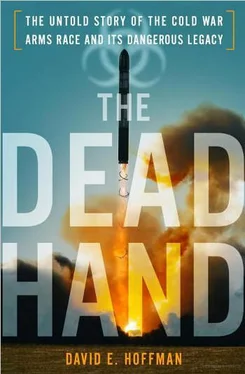Gorbachev: And this lasted for two and a half hours during which time the intruder aircraft was within the zone of the 6th Army? Did they report it to you?
Lushev: No. I learned about it after the aircraft’s landing in Moscow. Gorbachev: Learned from the traffic police?
Lushev described the existing orders not to shoot down a civilian plane but force it to land. The jet fighters were going too fast to do this. Ryzhkov, the head of the government, asked, “And helicopters, wasn’t it possible to use them?” Lushev replied, “There are no helicopters” in the Air Defense Forces.
Summing up, Lushev said the reasons for the episode were “a loss of vigilance and a dulled sense of responsibility, especially on duty shifts,” and “carelessness of the duty officers, who had grown used to routine action and were unprepared to operate in non-standard circumstances.”
Gorbachev: “And then how are we going to operate in combat conditions, when non-standard situations occur?”
Gorbachev fired the head of the Air Defense Forces and accepted Defense Minister Sokolov’s resignation on the spot. About 150 senior officers were also fired. Dmitri Yazov, a mild-mannered former deputy defense minister, was appointed to succeed Sokolov. The one top military man who was untouched by the affair was Akhromeyev.
Gorbachev called Chernyaev at home that evening. “We discredited the country, humiliated our people,” Gorbachev said, according to Chernyaev’s account. Gorbachev wondered if he should have resigned too. Then he added, “But fine, at least everyone here, and in the West, will know where power lies. It is in the hands of the political leadership, the Politburo. This will put an end to gossip about the military’s opposition to Gorbachev, that he’s afraid of them, and they are close to ousting him.” 34
On June 12, 1987, in Berlin, Reagan stood before the Brandenburg Gate, a symbol of Europe’s division between East and West, and addressed Gorbachev directly. “We hear much from Moscow about a new policy of reform and openness,” he said. “Are these the beginnings of profound changes in the Soviet state? Or are they token gestures, intended to raise false hopes in the West or to strengthen the Soviet state without changing it?
“General Secretary Gorbachev,” Reagan declared, “if you seek peace—if you seek prosperity for the Soviet Union and Eastern Europe—if you seek liberalization, come here, to this gate. Mr. Gorbachev, open this gate. Mr. Gorbachev, tear down this wall!”
The speech was classic Reagan, infused with his powerful faith in freedom and prosperity and the link between the two. Reagan recalled in his memoir that when he saw the wall, he spoke with genuine anger in his voice. Gorbachev still did not entirely understand Reagan, nor his rhetoric, and called Chernyaev a few days later. “He is trying to provoke us, to make us snap, which would help them get the Soviet threat back. If, like Reagan, I was giving interviews every week, I would say that he hasn’t forgotten his previous occupation over these eight years.” 35
———
Gorbachev’s retreat from the arms race led to confusion not only in the military but in the prestigious defense institutes and design bureaus. They needed to find new justifications for their programs. And Reagan’s missile defense dream still flummoxed some of them. Katayev recalled that in August, Alexander Nadiradze, the missile designer who created the Pioneer, sent a panicky letter to the Central Committee. Four years after Reagan had first announced the Strategic Defense Initiative, Nadiradze declared he had figured out the truth: it was a plan to use space to shoot a nuclear warhead back down to Earth! This was worse than first strike. He said the missile defense plan should be exposed as an “aggressive weapon that gives the USA a new possibility to deliver an instant nuclear strike against the Soviet Union.” He claimed his research showed “an undersized missile ‘Space-Earth’ will be capable of carrying a nuclear charge of 0.1–0.15 megaton, a solid-fueled rocket engine will allow it to accelerate toward Earth–at about 4–5 kilometers per second–in 30 seconds.” He added, “From the moment of the order to launch, the time of the rocket’s flight to Earth will be only 1–2 minutes.” Nadiradze said if Reagan’s program were deployed, then the Soviet Union should destroy American satellites in space. The Polyus and the Skif might be dead, but the hopes of the missile designers burned on. 36
In early September, Velikhov, the open-minded physicist, struck another hammer blow against Soviet military secrecy.
Thomas B. Cochran, the American scientist who had set up the seismic monitoring stations around Semipalatinsk, was traveling with three members of Congress, several aides and a New York Times journalist, showing them the equipment. On a stopover in Moscow, Velikhov telephoned Cochran at the Sovietskaya Hotel, about 6 P.M., and told him to get the delegation to the airport by midnight. Velikhov had won permission to take them to see the disputed Krasnoyarsk radar that the Reagan administration said was a treaty violation.
Velikhov was attempting exactly the kind of glasnost gamble the Central Committee had rejected in February. The group took off for Siberia at 4 A.M., reached the radar site in late afternoon and slowly circled the entire radar site by helicopter, looking down on two large concrete structures, one a transmitter and the other a receiver. The receiver, nearly thirty stories tall, had a long, sloping side, facing northeast. Both structures were unfinished; the receiver’s radar face appeared to be partially covered with corrugated metal sheets. At first the Soviets said the Americans could not go inside the structures. After a meal of roasted pig, fruit and vodka toasts in a large white tent, the Americans pleaded for a chance to go inside, and the Soviets relented. The Americans discovered the project was years from completion, just empty shells, empty rooms and no electronics. Judging by what they could see, the visitors concluded it would not be a battle management system, as the Reagan administration claimed. For one thing, a battle management system would be hardened against a nuclear blast; this structure was not. Nor did it look like it was dedicated to space-tracking, as the Soviets claimed. 37Although they could not be sure, the visitors surmised it was probably an early warning radar, pointing in the wrong direction. It was not facing outward, as required by the ABM treaty. What was most remarkable was that the congressmen got an eyewitness look at a top-secret site. The team took over one thousand photographs and made an hour of video, and no one tried to interfere. Velikhov’s openness undercut both the American propaganda and the Soviet lie. “It’s the beginning of military glasnost,” said Representative Tom Downey, D-N.Y., who led the delegation. In their report, the congressmen said the chances that it was a battle management radar were “extremely low.” Yet even with such an extraordinary firsthand look, Downey and the others did not change the Reagan administration’s view.
In Moscow, the top level of the Soviet leadership was privately at a loss about what to do with Krasnoyarsk. They knew the radar was a violation of the treaty, but they had not admitted it. They also knew that their public explanation of its purpose (space-tracking), as well as Reagan’s claims (battle management), were both untrue. On October 23, Gorbachev told Shultz that there would be a one-year moratorium on construction. Shultz replied that the United States would accept nothing short of dismantlement. A month after that, on November 21, an internal memo from the Big Five ministers suggested that the Soviet Union should continue to attempt to pressure the United States for some concessions in exchange for giving up the radar. The prospect of dismantling the whole thing was already being discussed internally. But the memo did not suggest an admission that the radar was in violation of the treaty. 38
Читать дальше












